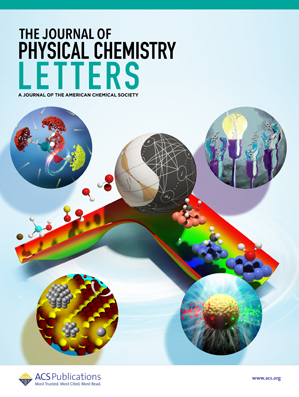用等变变压器加速分子动力学模拟凝聚态的二维电子能谱
IF 4.8
2区 化学
Q2 CHEMISTRY, PHYSICAL
引用次数: 0
摘要
二维电子能谱(2DES)提供了关于分子、蛋白质和固态材料的电子状态如何相互作用及其周围环境的丰富信息。原子分子动力学模拟为揭示核运动如何介导电子能量松弛及其在电子能谱中的表现提供了一条有吸引力的途径,但计算成本很高。本文表明,通过使用基于等变变压器的机器学习架构,仅训练2500个基态和100个激发态电子结构计算,可以构建精确的基态电子表面和激发态能隙的机器学习势能面。我们展示了这种方法在模拟尼罗蓝在乙醇中的动力学中的效用,我们通过实验验证和分解模拟的2DES来建立发色团和溶剂的核运动,这些核运动耦合到激发态,将光谱信号连接到它们的分子起源。本文章由计算机程序翻译,如有差异,请以英文原文为准。
Two-Dimensional Electronic Spectroscopy in the Condensed Phase Using Equivariant Transformer Accelerated Molecular Dynamics Simulations
Two-dimensional electronic spectroscopy (2DES) provides rich information about how the electronic states of molecules, proteins, and solid-state materials interact with each other and their surrounding environment. Atomistic molecular dynamics simulations offer an appealing route to uncover how nuclear motions mediate electronic energy relaxation and their manifestation in electronic spectroscopies but are computationally expensive. Here we show that by using an equivariant transformer-based machine learning architecture trained with only 2500 ground state and 100 excited state electronic structure calculations, one can construct accurate machine-learned potential energy surfaces for both the ground-state electronic surface and excited-state energy gap. We demonstrate the utility of this approach for simulating the dynamics of Nile blue in ethanol, where we experimentally validate and decompose the simulated 2DES to establish the nuclear motions of the chromophore and the solvent that couple to the excited state, connecting the spectroscopic signals to their molecular origin.
求助全文
通过发布文献求助,成功后即可免费获取论文全文。
去求助
来源期刊

The Journal of Physical Chemistry Letters
CHEMISTRY, PHYSICAL-NANOSCIENCE & NANOTECHNOLOGY
CiteScore
9.60
自引率
7.00%
发文量
1519
审稿时长
1.6 months
期刊介绍:
The Journal of Physical Chemistry (JPC) Letters is devoted to reporting new and original experimental and theoretical basic research of interest to physical chemists, biophysical chemists, chemical physicists, physicists, material scientists, and engineers. An important criterion for acceptance is that the paper reports a significant scientific advance and/or physical insight such that rapid publication is essential. Two issues of JPC Letters are published each month.
 求助内容:
求助内容: 应助结果提醒方式:
应助结果提醒方式:


